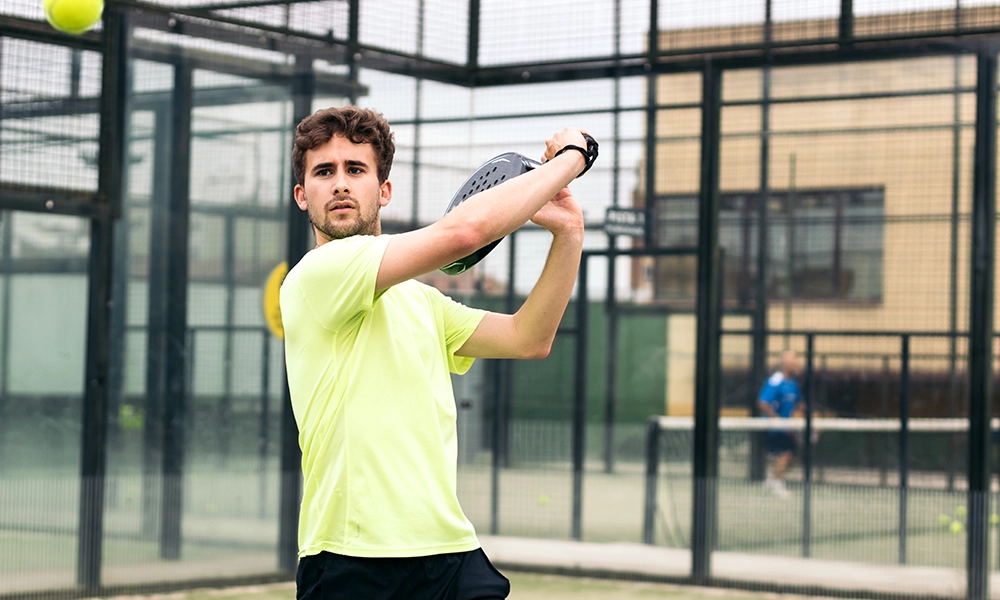At first glance, padel and tennis might look like close cousins both involve rackets, balls and a net. But ask anyone who plays both, and they’ll tell you: they’re very different games.
As the popularity of padel in the UAE continues to skyrocket, many tennis players (and curious beginners) are asking: Padel vs Tennis — what’s the difference, and which one is right for me?
Here’s a complete guide to help you understand the key differences between these two racquet sports from the rules and gear, to the playing style and court layout.
- Court Size & Setup
Tennis Court:
• Much larger in size: 23.77m x 10.97m for doubles.
• Open court, no walls.
• Singles and doubles formats.
Padel Court:
• Smaller: 20m x 10m and enclosed with glass walls.
• Always played in doubles (though some single courts exist).
• Walls are part of the play similar to squash.
Padel UAE courts are typically built with turf flooring and enclosed glass, creating a fast-paced and dynamic playing environment.
2. Rackets
Tennis Racket:
• Stringed and larger.
• Requires more wrist strength and technique to control spin and power.
Padel Racket:
• Smaller and solid, with perforated holes (no strings).
• Easier to handle, more beginner-friendly.
• Great for quick reaction and control near the net.
Looking to get started? Many padel racket UAE shops offer beginner models with great control and comfort.
3. Balls
• Padel balls look similar to tennis balls but are slightly less pressurized, which makes them bounce lower and move slower.
• This helps extend rallies and makes padel more accessible for all skill levels.
If you’re buying balls online, make sure to get ones made specifically for padel, not regular tennis balls.
4. Rules & Scoring
Both sports use the same scoring system (15-30-40-game) and sets, but gameplay is quite different:
Padel:
• Serve is underhand and must bounce before hitting the opponent’s court.
• Walls are in play after the first bounce, adding a strategic twist.
• Rallies are longer due to slower ball speed and wall rebounds.
• Fast footwork, positioning, and teamwork matter more than brute strength.
Tennis:
• Serve is overhead, often aggressive.
• No walls, so court coverage is key.
• The game often favors power, spin and shot placement.
5. Style of Play
If you’re comparing tennis vs padel, the feel of the game is often what separates them most.
Tennis:
• Fast-paced with wide, open shots.
• Demands strong serves, deep groundstrokes and physical endurance.
• Singles play is popular and very physical.
Padel:
• Tactical and fast, with shorter reaction time.
• Emphasis on placement, strategy, and communication between partners.
• The wall bounces make it less about raw power and more about smart play.
In short: padel is easier to learn but still challenging to master, making it ideal for casual players and competitive athletes alike.
6. Social & Accessibility
Padel is often seen as more social and beginner-friendly.
• In the UAE padel scene, you’ll find mixed-level games, corporate leagues and lots of first-time players.
• Tennis clubs can be more traditional and skill-based, though also very rewarding once you’re up to speed.
If you’re looking for a sport that’s easy to get into and fun from day one, padel might be your game.
7. Padel vs Tennis in the UAE
While tennis remains a classic favorite in the UAE, padel in Dubai, Abu Dhabi, and across the Emirates is booming. New padel courts in UAE are opening every month, and clubs are offering beginner packages, tournaments and coaching for all levels.
More and more tennis players are switching or at least adding padel to their weekly sports routine thanks to its fast learning curve and social nature.
Frequently Asked Questions
1. Is padel easier than tennis?
Yes, many players find padel easier to learn than tennis, especially beginners. The smaller court, underhand serve and slower ball speed make it more accessible and less physically demanding early on.
2. What is the main difference between padel and tennis?
The main differences are:
• Court size and walls (padel uses enclosed courts with glass walls)
• Racket type (padel uses solid rackets without strings)
• Serving style (padel serves are underhand)
• Padel is usually played in doubles, while tennis is commonly played in both singles and doubles.
3. Can tennis players switch to padel easily?
Yes! Many tennis players transition to padel with ease. While the technique is different, the movement, timing and general ball skills are transferable. Some adjustments are needed, especially for using the walls effectively.
4. Do padel and tennis use the same balls?
Not exactly. Padel balls look like tennis balls, but they are slightly smaller and less pressurized. This makes them bounce lower and move more slowly, which is ideal for the smaller, enclosed padel court.
5. Is padel more physically demanding than tennis?
Tennis typically requires more running and endurance due to the larger court and singles format. Padel involves quick, explosive movement in a smaller space, so while it’s easier on the body, it’s still a great workout.

